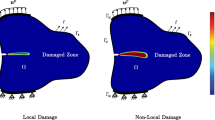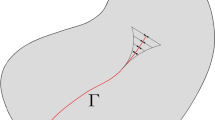Abstract
The present work deals with development of method called direct displacement control (DDCM) that explicitly imposes the incremental displacement without recourse to pseudo force vector while solving nonlinear problems from solid mechanics. The limitation of the approaches, generalized displacement control method and displacement control method are overcome in DDCM approach while achieving faster inter-element force balance in finite element framework (FEF). The important application of DDCM is proposed to be elasto-plastic damage (EPD), as the damage-induced softening makes internal force balance difficult. The 1D local, and 1D and 2D nonlocal EPD formulations are developed; the derivation of 1D algorithmic tangent modulus is proposed. The applicability and correctness of DDCM approach are successfully demonstrated solving several 1D and 2D local and nonlocal EPD problems within FEF (in-house code and ABAQUS®).










Similar content being viewed by others
References
Crisfield, M.: Non-Linear Finite Element Analysis of Solids and Structures: Advanced Topics. Wiley, Hoboken (1997)
Wang, S., Fu, S., Zhang, C., Chen, W.: Thermo-mechanical coupled modelling on fixed joint interface in machine tools. Int. J. Mater. Struct. Integrity 8(1–3), 121 (2014)
Clarke, M.J., Hancock, G.J.: A study of incremental-iterative strategies for non-linear analyses. Int. J. Numer. Methods Eng. 29(7), 1365 (1990)
Huang, J., Griffiths, D.: Return mapping algorithms and stress predictors for failure analysis in geomechanics. J. Eng. Mech. 135(4), 276 (2009)
Voyiadjis, G., Taqieddin, Z.: Elastic plastic and damage model for concrete materials: part i—theoretical formulation. Int. J. Struct. Changes Solids Mech. Appl. 1(1), 31 (2009)
Yang, Y., Leu, L., Yang, J.: Key considerations in tracing the postbuckling response of structures with multi winding loops. Mech. Adv. Mater. Struct. 14(3), 175 (2007)
Yaw, L.: 2D co-rotational truss formulation, https://gab.wallawalla.edu pp. 1–15 (2009)
Mulay, S., Udhayaraman, R., Anas, M.: Comparative study of algorithms to handle geometric and material nonlinearities, 3rd Indian conference on applied mechanics pp. 1–19 (2017)
Milan, J., Djimédo, K., Cino, V.: Damage and fracture in geomaterials. Europ. J. Civil Eng. 11, 7–8 (2007)
Andrade, F., Andrade Pires, F., César de Sá, J., Malcher, L.: Improvement of the numerical prediction of ductile failure with an integral nonlocal damage model. Int. J. Mater. Form. 2(1), 439 (2009)
Andrade, F., César de Sá, J., Andrade Pires, F., Malcher, L.: Nonlocal formulations for lemaitre’s ductile damage model. In: X International Conference on Computational Plasticity pp. 1–4 (2009)
Nguyen, N., Bui, H., Nguyen, G., Kodikara, J.: A cohesive damage-plasticity model for DEM and its application for numerical investigation of soft rock fracture properties. Int. J. Plast. 98, 175 (2017)
Haddag, B., Abed-Meraim, F., Balan, T.: Strain localization analysis using a large deformation anisotropic elastic-plastic model coupled with damage. Int. J. Plast. 25(10), 1970 (2009)
Haddag, B., Abed-Meraim, F., Tudor, B.: Finite element prediction of sheet forming defects using elastic-plastic. Damage Local. Models AIP Conf. Proceed. 908(1), 227 (2007)
Lemaitre, J.: A continuous damage mechanics model for ductile fracture. J. Eng. Mater. Technol. 107(1), 83 (1985)
Shojaei, A., Li, L., Tan, P., Fish, J.: Dynamic delamination in laminated fiber reinforced composites: a continuum damage mechanics approach. Int. J. Solids Struct. 71, 262 (2015)
Xu, Q., Chen, J., Li, J., Xu, G.: Coupled elasto-plasticity damage constitutive models for concrete. J. Zhejiang Univ. Sci. A 14(4), 256 (2013)
Zhou, F., Cheng, G.: A coupled plastic damage model for concrete considering the effect of damage on plastic flow. Math. Probl. Eng. 2015, 1 (2014)
Sciarra, F.: A nonlocal model with strain-based damage. Int. J. Solids Struct. 46(22), 4107 (2009)
Sciarra, F.: Nonlocal plasticity and damage, The 2013 world congress on advances in structural engineering and mechanics (ASEM13) pp. 1 – 10 (2013)
Voyiadjis, G., Taqieddin, Z., Kattan, P.: Theoretical formulation of a coupled elastic-plastic anisotropic damage model for concrete using the strain energy equivalence concept. Int. J. Damage Mech. 18(7), 603 (2009)
Jason, L., Huerta, A., Pijaudier-Cabot, G., Ghavamian, S.: An elastic plastic damage formulation for concrete: application to elementary tests and comparison with an isotropic damage model. Comput. Methods Appl. Mech. Eng. 195(52), 7077 (2006)
Fang, L., Qiang, F., Cen, C., Naigang, L.: An elasto-plastic damage constitutive theory based on pair functional potentials and slip mechanism. Chin. J. Aeronaut. 23(6), 686 (2010)
Zhao, L., Zhu, Q., Shao, J.: A micro-mechanics based plastic damage model for quasi-brittle materials under a large range of compressive stress. Int. J. Plast. 100, 156 (2018)
Mulay, S., Udhayaraman, R.: On the constitutive modelling and damage behaviour of plain woven textile composite. Int. J. Solids Struct. 156–157, 73 (2019)
Pirondi, A., Bonora, N., Steglich, D., Brocks, W., Hellmann, D.: Simulation of failure under cyclic plastic loading by damage models. Int. J. Plast. 22(11), 2146 (2006)
Skamniotis, C., Elliott, M., Charalambides, M.: On modelling the constitutive and damage behaviour of highly non-linear bio-composites—Mesh sensitivity of the viscoplastic-damage law computations. Int. J. Plast. 114, 40–62 (2018)
Brünig, M., Gerke, S., Hagenbrock, V.: A Continuum damage and failure model based on stress-state-dependent criteria. In: Proceedings of the ASME 2012 11th Biennial Conference on Engineering Systems Design and Analysis (2012)
Vignjevic, R., Djordjevic, N., Panov, V.: Modelling of dynamic behaviour of orthotropic metals including damage and failure. Int. J. Plast. 38, 47 (2012)
Batoz, J., Dhatt, G.: Incremental displacement algorithms for nonlinear problems. Int. J. Numer. Methods Eng. 14(8), 1262 (1979)
Burnett, D.: Finite Element Analysis: From Concepts to Applications. Addison Wesley, New York (1987)
Kachanov, M.: On the concept of damage in creep and in the brittle-elastic range. Int. J. Damage Mech. 3(4), 329 (1994)
Kachanov, L.: Introduction to Continuum Damage Mechanics. Springer, Berlin (2013)
Murakami, S.: Continuum Damage Mechanics. Springer, Berlin (2012)
Lemaitre, J.: A Course on Damage Mechanics. Springer, Berlin (1996)
Yaw, L.: Nonlinear Static - 1D Plasticity - Various Forms of Isotropic Hardening, Walla Walla University pp. 1–25 (2012)
Yaw, L.: Nonlinear Static - 1D Plasticity - Isotropic and Kinematic Hardening, Walla Walla University pp. 1–22 (2017)
Simo, J., Hughes, T.: Computational Inelasticity. Springer, Berlin (1998)
César de Sá, J., Andrade, F., Andrade Pires, F.: Theoretical and numerical issues on ductile failure prediction—an overview. Comput. Methods Mater. Sci. 10(4), 279 (2010)
Bažant, Z., Jirásek, M.: Nonlocal integral formulations of plasticity and damage: survey of progress. J. Eng. Mech. ASCE 128(11), 1119 (2002)
Nguyen, V., Lani, F., Pardoen, T., Morelle, X., Noels, L.: A large strain hyperelastic viscoelastic-viscoplastic-damage constitutive model based on a multi-mechanism non-local damage continuum for amorphous glassy polymers. Int. J. Solids Struct. 96, 192 (2016)
de Souza Neto, E., Peric, D., Owen, D.: Computational Methods for Plasticity: Theory and Applications. Wiley, Hoboken (2008)
Acknowledgements
The author gratefully acknowledges the financial support provided by VSSC, ISRO, India, under Project number ICSR/ISRO-IITM/ASE/14-15/SHAT. The author also gratefully acknowledges several technical discussions with Prof. Shyam Keralavarma of the Aerospace engg. dept. of IIT Madras, which helped in the validation of several derived equations in the present work.
Author information
Authors and Affiliations
Corresponding author
Additional information
Publisher's Note
Springer Nature remains neutral with regard to jurisdictional claims in published maps and institutional affiliations.
Rights and permissions
About this article
Cite this article
Mulay, S.S., Subramanian, H. On the development of direct displacement control method: application to local and nonlocal damage mechanics. Int J Adv Eng Sci Appl Math 12, 101–124 (2020). https://doi.org/10.1007/s12572-020-00274-6
Accepted:
Published:
Issue Date:
DOI: https://doi.org/10.1007/s12572-020-00274-6




